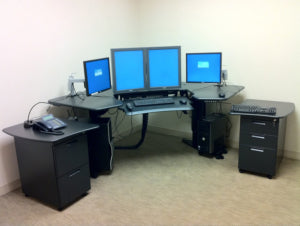In the ever-evolving field of medical imaging informatics, where precision and efficiency are paramount, ergonomic standing desks are emerging as an indispensable tool for radiologists and healthcare professionals. Therefore, Biomorph delves into the pivotal role of ergonomic standing desks in imaging informatics, exploring how they elevate productivity, promote well-being, and contribute to superior patient care.
STREAMLINING WORKFLOWS AND EFFICIENCY:
Imaging informatics demands seamless integration and rapid analysis of complex medical images. Ergonomic standing desks provide an optimal work environment for radiologists to navigate through vast datasets efficiently. With effortless transitions between sitting and standing, radiologists can swiftly interact with imaging systems, leading to accelerated diagnoses and streamlined workflows.
ENHANCING DIAGNOSTIC ACCURACY:
Radiologists’ ability to make accurate diagnoses is of utmost importance in imaging informatics. The ergonomic design of standing desks fosters a more upright and attentive posture, reducing strain on the neck and back. Consequently, this improved alignment enhances focus and concentration, leading to heightened diagnostic precision and reduced risk of errors.
PROMOTING RADIOLOGISTS’ WELL-BEING:
Long hours of image interpretation and data analysis can take a toll on radiologists’ physical well-being. Prolonged sitting at traditional desks can lead to musculoskeletal discomfort and fatigue. Ergonomic standing desks offer an alternative, allowing radiologists to stand and move freely throughout the day. By encouraging a healthier and more dynamic work environment, standing desks promote radiologists’ well-being and reduce the risk of work-related health issues.
PERSONALIZING STANDING DESK WORKSTATIONS FOR RADIOLOGISTS:
Imaging informatics involves intensive screen time, which can strain the eyes and lead to digital eye fatigue. Ergonomic standing desks, coupled with adjustable monitor heights and distances, enable radiologists to customize their workstations. Personalized configurations reduce eye strain, enhance visual comfort, and cater to individual preferences, ultimately improving overall work satisfaction.
FACILITATING COLLABORATIVE WORK:
Collaboration is a cornerstone of imaging informatics. Ergonomic standing desks with ample space and adaptable features promote dynamic teamwork and knowledge exchange. Radiologists can easily collaborate with colleagues, sharing insights and discussing cases, creating a more vibrant and supportive work environment.
ADAPTING TO EVOLVING TECHNOLOGIES:
 Imaging informatics is continuously evolving with advancements in AI, machine learning, and data analytics. As a result, ergonomic standing desks provide a versatile foundation to accommodate emerging technologies. Additionally, Radiologists can seamlessly adapt their workstations to integrate evolving imaging systems and capitalize on cutting-edge tools, ensuring their practices stay at the forefront of medical innovation.
Imaging informatics is continuously evolving with advancements in AI, machine learning, and data analytics. As a result, ergonomic standing desks provide a versatile foundation to accommodate emerging technologies. Additionally, Radiologists can seamlessly adapt their workstations to integrate evolving imaging systems and capitalize on cutting-edge tools, ensuring their practices stay at the forefront of medical innovation.
The fast-paced realm of imaging informatics, ergonomic standing desks prove to be a game-changer for radiologists and healthcare professionals alike. From streamlining workflows and enhancing diagnostic accuracy to promoting well-being and fostering collaboration, the advantages of standing desks in imaging informatics are undeniable. By prioritizing the ergonomics of workstations, healthcare facilities can empower their radiologists with an optimal environment. This sets the stage for improved efficiency, superior patient care, and a brighter future in medical imaging informatics.

